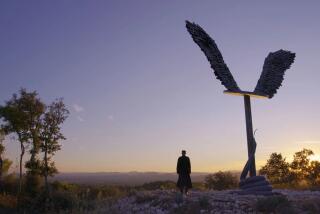Wilshire Center
- Share via
A Worthy Figure: Werner Drewes--a student at both the Weimar and Dessau Bauhaus schools who emigrated to the United States in 1930--was something of a jack-of-all-trades in art. Intrigued by color relationships, he studied stained-glass design as a young man. During his long career (he died in 1985), Drewes produced paintings, watercolors, etchings, color woodcuts, lithographs and collages. An exhibit of 152 works dating mostly from the ‘40s and ‘70s introduces a worthy secondary figure on the American scene.
Not an innovator, Drewes nonetheless had a rhythmic feel for geometric patterning, a fine eye for color and a knack for concocting tiny, drolly meaningful collages. He was also a deft portraitist: a group of woodcuts demonstrates distinctly different techniques for conveying the spirit of each sitter. Although he doesn’t appear to have updated his stylistic approach noticeably after the early ‘50s, many works of his middle and old age display the ease and lightness of careless youth.
In “Aquatic Ballet,” a color woodcut from 1979, a medley of fanciful purple and orange shapes bob in close-knit ranks, with color laid over color to yield a porous effect. Posing plumply in an airy, turquoise-and-yellow celloprint from 1952, nude Nausikaa (who rescued shipwrecked Odysseus in Homer’s “Odyssey”) looks in need of a proper New Yorker cartoon punch line. In “Satellites,” a painting from 1984, Drewes combines soft, bright color, simple geometry--and the same penchant for tight construction that, 40 years earlier, led him to reorganize a “View of the Bay” into a warren of small compartments holding sailboats and rocks. (Tobey C. Moss Gallery, 7321 Beverly Blvd., to March 31.)
More to Read
The biggest entertainment stories
Get our big stories about Hollywood, film, television, music, arts, culture and more right in your inbox as soon as they publish.
You may occasionally receive promotional content from the Los Angeles Times.










